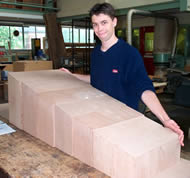Ben, a medical student at Queens' College, suffers from Cystic Fibrosis.

In common with other sufferers, he has to spend two hours a day doing breathing exercises and physiotherapy. This requires the use of a special bed which supports him with his head lower than his feet. Provided Ben follows this regime, he remains in reasonably good health and would like to take advantage of the opportunities student life brings by travelling in the vacations. However the 'portable' bed he uses for his exercises weighs 28 kilos and is very large. Without it, his health is likely to suffer. What he needs is a portable light weight bed, that can be easily transported on airlines.
Alerted to Ben's plight by Dr David Cebon, Director of Studies for Engineering at Queens', a group of Engineering students decided to help out.
Their initial research established allowable sizes and weights for luggage to be carried on to aircraft and as a result, the students came up with a new design of bed: a set of nesting boxes that fit together (on the same principle as nesting Russian dolls) to form a wedge shape. Being good engineers, they then used materials selection charts to establish the best material to make this bed.
Surprisingly, plywood was the answer, with carbon fibre composite also a possibility (the latter having some advantages for ease of manufacture). With sponsorship from Unilever to cover their costs, the students have made a prototype. Made from 4mm thick plywood, the prototype weighs a mere 6.6 kilos, with an overall size which should be small and light enough for air travel. The plywood sections are each covered in fabric and the whole can be carried with a handle. It acts as its own case and may be ideal for hand luggage. On unpacking, the sections are held together using Velcro strips.
The team involved with making the bed are David Howey (studying EIST), Andy Odhams (Mechanical Engineering) and Pete Hewett (MET).

